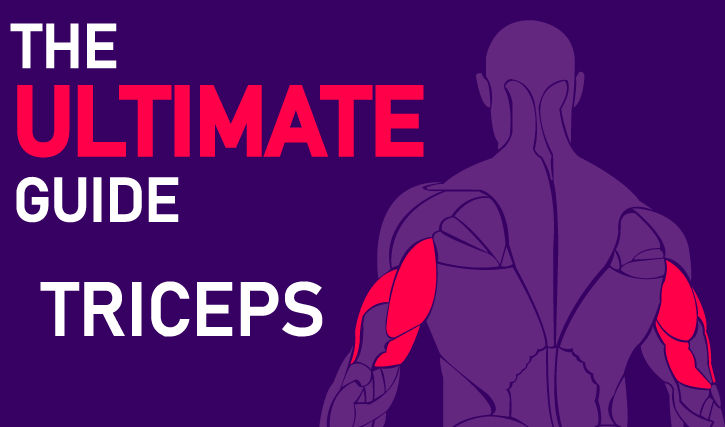
One of the more popular gym goals folks have is to increase their arm size.
Training the biceps is undoubtedly an important component of this.
However, it should be noted the triceps are roughly 2.5 times larger than the biceps.

Therefore, triceps training should not be underestimated when it comes to increasing arm size.
Table of Contents
- Anatomy/Physiology of Triceps
- High Reps vs Low Reps for Triceps Growth
- The Medial Head May Be Harder to Grow
- Role of Each Triceps Head During Various Elbow Extension
- How Good Are Compound Exercises for Triceps Hypertrophy?
- Why Isolation Exercises Are Likely Necessary For Triceps Hypertrophy
- High vs Low Volumes for Triceps Growth
- High vs Low Frequency for Triceps Growth
- Can Hypoxia Methods Enhance Triceps Hypertrophy?
- Summary
Anatomy/Physiology of Triceps
The triceps consist of three muscles: the long head, medial head, and lateral head.

In some individuals, a fourth head has been observed. However, given it’s considered rare and I’m unaware of research about this head relating to muscle growth, we’ll ignore it.
Both the medial and lateral head originates from the back of the humerus. The humerus refers to the upper arm bone. The precise location for the lateral head is just above an area called the radial groove, while the location for the medial head is just below the radial groove.
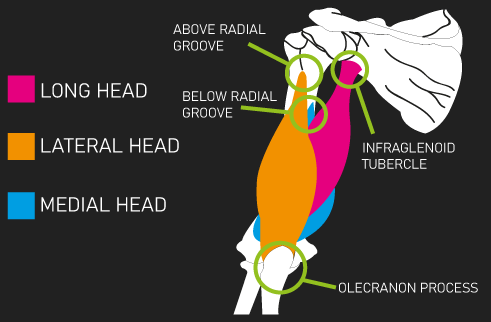
Conversely, the long head originates from the scapula. The scapula refers to the shoulder blades. The precise location is at an area called the infraglenoid tubercle.
All three muscles insert into around the same location, the ulna. The ulna is one of the forearm bones. The precise location is at an area called the olecranon process.
Two studies indicate the long head is the largest muscle of the triceps. With regards to the lateral and medial head, one of the studies indicates the lateral head is larger than the medial head, whereas the other study indicates the opposite of this.
Of course, individual differences likely exist. The size of the medial and lateral head may be more individualized.
As all three heads cross the elbow joint, they all play a role during elbow movement. Specifically, all three heads actively extend the elbow.
Also, remember, the long head originates at the scapula and therefore crosses the shoulder joint. Therefore, as it crosses the shoulder and elbow joints, it is called a two-joint muscle.
This is in contrast to the medial and lateral head, which only cross the elbow joint. Resultingly, they are only one-joint muscles.
As the long head crosses the shoulder joint, it also appears to play an active role in shoulder extension and shoulder adduction.

That said, evidence indicates the long head’s contribution to shoulder extension is small. The same thing may also apply to shoulder adduction.
Therefore, I think it’s likely exercises involving only shoulder extension or shoulder adduction probably do not substantially stimulate the long head.
High Reps vs Low Reps for Triceps Growth
Moving on, combining the results from a few papers, the triceps overall appears to be comprised of more fast-twitch muscle fibers than slow-twitch fibers.

Slow-twitch fibers are highly resistant to fatigue but produce low amounts of power, while fast-twitch fibers produce are less resistant to fatigue but produce high amounts of power.
As the triceps appear to be made up of more fast-twitch fibers, I’ve come across recommendations that you should use low reps and heavy weight to optimize triceps hypertrophy.
However, the current evidence would not support this recommendation.
Schoenfeld et al. split 18 men with an average of 3 and a half years of training experience into a low load or high load group.
Both groups trained the same 7 exercises for 3 sets with 90 seconds of rest between sets, three times per week for 8 weeks.
In this study, the bench press and overhead press were the two exercises that trained the triceps.
The high load group trained each exercise with a load that allowed them to perform 8-12 reps to failure (the point at which no more repetitions can be performed) each set.
The low load group trained each exercise with a load that allowed them to perform 25-35 reps to failure each set.
Thickness of the triceps, measured at 60% of the upper arm length, was similar between the high load and light load group.

Some of you may be thinking that using an 8-12 rep load isn’t heavy enough. Fortunately, there is another paper by Schoenfeld et al. looking at heavier loads.
19 men with an average of 4 and a half years of experience were split into a heavy or moderate group.
Both groups trained the same 7 exercises for 3 sets each with 2 minutes of rest between sets, 3 times per week for 8 weeks.
Like the last study, the bench press and overhead press were the two exercises that trained the triceps.
The heavy group used a load that allowed them to perform 2 to 4 to failure each set.
The moderate group used a load that allowed them to perform 8-12 reps to failure each set.
Increases in triceps thickness, measured at 60% of the upper arm length, seemed to slightly favor the moderate group.

Therefore, 8-12 rep loads may be slightly better for triceps hypertrophy than 2-4 rep loads.
As a side note, the overall research seems to indicate reps between 5 and 35 produce similar hypertrophy, provided those reps are performed to or very close to failure. This very likely applies to the triceps.
The Medial Head May Be Harder to Grow
Now, the fiber type numbers shown just a moment ago combined results from numerous studies looking at different heads or regions of the triceps.
I was able to find one human study by Elder et al. assessing the fiber type composition of each triceps head.

Both the lateral and long heads appear to be more fast-twitch than slow-twitch. However, the medial head appears to be more slow-twitch than fast-twitch.
Of course, this is only one study. Moreover, fiber type composition does vary between individuals.
Nevertheless, if the medial head is on average more slow-twitch than fast-twitch, this might suggest the medial head may be slightly harder to grow than the long and lateral heads.
This is because fast-twitch muscle fibers seem to have a greater capacity for hypertrophy than slow-twitch fibers.
Interestingly, Wakahara et al. did find that after training the dumbbell triceps skull crusher for 12 weeks, increases in triceps cross-sectional area were fairly minimal at the lower regions. The lower regions primarily consisted of the medial head.

The authors speculated the minimal hypertrophy in this distal region was because the medial head is comprised of fewer fast-twitch fibers.
Role of Each Triceps Head During Various Elbow Extension
Let us now evaluate if the research provides us with details on the role of each triceps head during elbow extension, as well as elbow extension actions at various shoulder angles.
Remember, the long head crosses the shoulder joint. Therefore, it’s reasonable to assume that manipulating shoulder angle may change the contribution of each triceps head to elbow extension.
During elbow extension, all the way back in 1867, a researcher by the name of Duchenne suggested the medial and lateral head produce similar force, while the long head contributed less.
Since then, as you’d imagine, a lot more research has been published on the role of each triceps head during elbow extension.
Unfortunately, the research is completely conflicting.
Some papers agree with Duchenne, while others completely conflict. Moreover, a few papers also indicate all three heads produce the same relative force during elbow extension.
So, unfortunately, the research is far from clear on the contribution of each triceps head to elbow extension.
As for the impact of shoulder angle on the contribution of each triceps head to elbow extension, a study by Kholinne et al. examined this.

They found when performing elbow extension at 0 degrees of shoulder flexion, the medial and lateral head produce equal but less force than the long head.
During elbow extension at 90 degrees of shoulder flexion, the lateral and long head produced equal but less force than the medial head.
During elbow extension at 180 degrees of shoulder flexion, the medial head produced more force than the lateral head. The lateral head also produced more force than the long head.
However, a study by Davidson et al. found that the three triceps heads were all similarly relatively activated during elbow extension at 0 degrees and 180 degrees of shoulder flexion.
In total, the research, unfortunately, cannot provide us with strong evidence about the role of each triceps head during elbow extension, as well as during elbow extension at various shoulder angles.
Now, there is evidence different individuals display different activation and activation patterns of the triceps during the same tasks. These individual differences, to some degree, may explain the overall conflicting evidence. Other factors such as differences in equipment and methodology may also go some way to explaining the discrepancies.
Nonetheless, despite the research being unable to inform us of the contribution of each triceps head to various movements, there is other research, mainly long-term research, that can provide us with solid information on how we may maximize triceps hypertrophy.
How Good Are Compound Exercises for Triceps Hypertrophy?
Firstly, how effective are compound exercises for triceps development?
Compound exercises involve motion at two joints or more, resulting in multiple muscles being trained.
Generally, there are two types of compound exercises that target the triceps: horizontal presses and vertical presses.
Horizontal presses include exercises like the bench press, push-ups, and a machine chest press.
Vertical presses include exercises like the overhead press, handstand push-ups, and machine shoulder press.
Exploring horizontal presses first, an interesting study by Brandao et al. assessed how effective the bench press is at inducing triceps hypertrophy.
A group of untrained men trained the barbell bench press with a 2x-shoulder-width grip. They performed 3 to 5 sets to failure with an 80% one-rep max load and 3 minutes of rest between sets, twice per week for 10 weeks.

They experienced pretty good growth of the lateral head, fairly decent growth of the medial head, but very little growth of the long head.
By the way, for all three muscles, cross-sectional area measurements were taken at 50-60% of the upper arm length.
Therefore, it appears horizontal presses, like the bench press, may be particularly poor at developing the long head.
Adding further support to this, Wakahara et al. found that during a dumbbell bench press performed with a neutral hand position, activation of the long head, measured by T2 weighted imaging, was less than that of the medial and lateral heads.

Biomechanically, the finding that the long head is poorly trained with horizontal presses makes sense.
Remember, as the long head crosses the shoulder joint, it is actively involved in shoulder extension.
During the lowering phase of horizontal pressing exercises, where shoulder extension occurs, the long head shortens. As a result, it cannot actively contract and contribute to force production in the lifting phase of the movement.
As for vertical presses, I was, unfortunately, unable to find any long-term studies or reliable activation studies exploring the impact of vertical presses on the triceps.
That said, as there isn’t really any shoulder extension during the lowering phase of the movement, the long head is probably going to be involved in the elbow extension that occurs during vertical presses. Furthermore, I can’t think of any reason as to why the lateral and medial heads would not be involved to a good degree too. However, I do not say this with 100% confidence simply due to the absence of research.
Why Isolation Exercises Are Likely Necessary For Triceps Hypertrophy
Nevertheless, overall, although compound exercises are likely going to produce meaningful triceps hypertrophy, I believe the evidence would appear to suggest that to maximize and accelerate triceps hypertrophy, the inclusion of isolation exercises would be necessary.
Isolation exercises involve motion at one joint, resulting in one muscle group being primarily trained.
One of the reasons I believe isolation exercises may be necessary is because evidence indicates that within a muscle, there may be subpopulations of muscle fibers that have different functional roles.
Put differently, there could be different regions and groups of muscle fibers in the triceps that are activated more or less during different movements.
For instance, an extremely interesting study by Zuylen et al. identified 3 different subpopulations of muscle fibers within the triceps.
One subpopulation of fibers was activated during elbow extension, supination, or pronation of the hand, another subpopulation activated during elbow extension or supination of the hand, not pronation, while the last subpopulation activated during elbow extension only.

Now, this study only looked at the activation of a few groups of muscle fibers from all three heads during elbow extension, supination, or pronation of the hand, as well as various combinations of these movements.
Extrapolating from this study, I think it’s quite possible that within the triceps, there exist different subpopulations of muscle fibers that may be more or less activated during elbow extension at varying shoulder angles.
If true, this would indicate that performing triceps exercises with different shoulder angles could be beneficial for stimulating these subpopulations of fibers and therefore ensuring more balanced hypertrophy across the triceps.
Furthermore, I think it’s possible that during different stages of elbow extension, there also exist different subpopulations of muscle fibers that may be more or less activated.
If true, this would suggest using different triceps exercises that require maximal force production at different stages of elbow extension could be beneficial for stimulating these subpopulations of fibers and therefore ensuring more balanced hypertrophy across the triceps.
As an example, triceps pushdowns are most challenging closer to elbow lockout, where the triceps are close to being fully shortened. Conversely, lying triceps extensions appear to be most challenging when the triceps are more stretched.
Therefore, these two exercises may stimulate some regions of the triceps more so than others, making them complimentary in a training program.
If you were to only train your triceps with compound exercises, I think it’s highly likely you would be understimulating some subpopulation of muscle fibers.
For that reason, performing a few isolation triceps exercises on top of your compound exercises would probably be ultimately better for ensuring greater overall triceps development.
Furthermore, using a few different isolation exercises, rather than only one isolation exercise, is probably favorable.
A recent study by Costa et al. demonstrates these concepts nicely.
22 detrained men, who had not trained in the 6 months leading up to the study, were allocated into a non-varied or varied group.
We’ll only be focusing on the exercises and measurements done on the triceps, they did assess other muscles.
Both groups trained 3 times per week for 8 weeks. All exercises were trained with 3 sets of 8-12 reps with 90-120 seconds of rest between sets.
The non-varied group, each session, performed the barbell bench press and triceps pushdown.
The varied group, on day 1 of each week, also performed the barbell bench press and triceps pushdown.
But on day 2, they performed the incline bench press and cable seated triceps extension, and on day 3, the decline bench press and triceps kickback pulley.
Thickness of the overall triceps was measured at 50%, 60%, and 70% of the upper arm length.

Increases at all regions, particularly the 60% and 70% regions, appear to favor the varied group.
Therefore, this study would seem to suggest that a variety of exercises, including a variety of triceps isolation exercises, enhances overall triceps development.
There does exist some additional research regarding triceps isolation exercises that may be helpful.
Returning to the Brandao et al. study earlier, they also had a group of untrained men perform triceps skull crushers for 3 to 5 sets to failure with an 80% one-rep max load and 3 minutes of rest between sets, twice per week for 10 weeks.

Significant increases in cross-sectional area for the medial and long head were experienced. But interestingly, there was hardly any growth of the lateral head. For all these muscles, cross-sectional area was measured at 50 to 60% of the upper arm length.
Another study by Wakahara et al. supports these results. They found during dumbbell tricep skull crushers, activation of the lateral head, measured by T2 weighted imaging, was lower than medial and long head activation.

Unfortunately, I was unable to find any reliable evidence explaining why the lateral head may not be stimulated during triceps skull crushers.
Anyway, remember earlier we mentioned the Brandao et al. study demonstrates the barbell bench press produces pretty good lateral head growth.
Something I haven’t mentioned yet is the Brandao et al. study also had two other groups that trained both the barbell bench press and triceps skullcrushers.
One of these groups, in each session, performed the barbell bench press first followed by the triceps skullcrushers. Whereas the other group, in each session, performed the triceps skull crusher first followed by the barbell bench press.
As a note, both groups trained each exercise for 3 to 5 sets to failure with an 80% one-rep max load and 3 minutes of rest between sets, twice per week for 10 weeks.
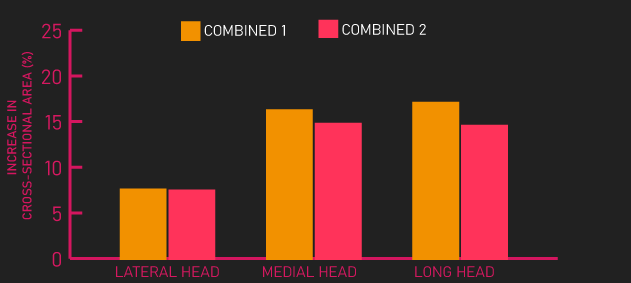
Both groups experienced significant cross-sectional increases for all three heads. This study nicely demonstrates how the addition of isolation exercises can be beneficial for overall triceps development.
However, all measurements were only taken at 50-60% of the upper arm length.
As discussed and demonstrated by the Costa et al. study, it’s likely a good idea to perform a variety of triceps isolation exercises to ensure more balanced growth across the triceps.
The final study I came across exploring triceps isolation exercises compared cable overhead extensions to cable pushdowns for long head hypertrophy.
9 untrained women had one arm assigned to train cable overhead extensions and their other arm assigned to train cable pushdowns.

The cable pushdowns started with the elbow at 90° and ended at 170° (180 is full elbow extension).
The cable overhead extensions started at 30° and ended at 110° of the elbow.
They trained each exercise for 6 sets of 6 reps to failure with 2 minutes of rest between sets, twice per week for 6 weeks.
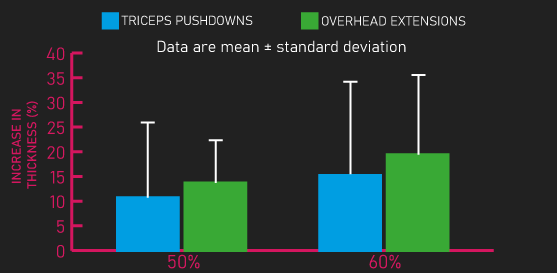
Increases in long head thickness, measured at 50% and 60% of the upper arm length, were statistically similar between both groups. However, the results appear to do seem to favor the arm that trained with cable overhead extensions.
There were only 9 subjects. Overhead extensions could produce more long head growth, but this study was just underpowered. But at this same time, the percentages supporting the overhead extensions could simply be a result of random variation.
If the long head is best trained with overhead elbow extension exercises, this would indeed match conventional bodybuilding wisdom. However, I think more research would be needed to confirm this.
Wrapping up the conversation on exercise selection, as a general rule of thumb, performing 2-3 isolation tricep exercises (like what was used in the Costa et al study) in addition to your compound exercises is probably a sensible way to ensure sufficient overall triceps development.
As discussed, performing exercises that involve elbow extension at varying shoulder angles could be beneficial. For instance, you may include an overhead extension, triceps skull crusher, and press down in your program.
Performing a variety of exercises will typically result in you having a variety of triceps exercises that involve maximal forces at different degrees of elbow extension. As we mentioned earlier, this is likely beneficial, as exercises that involve maximal forces at different stages of elbow extension could target some subpopulation of muscle fibers more than others.
Before moving on, if you’re curious about creating an effective training program for muscle hypertrophy, our high quality partner Alpha Progression can help. It can generate a highly effective program for you, track your workouts live with in-built progression recommendations, provide graphs displaying your long term progress, and it has a massive exercise database with more than 550 exercises.
Click HERE (the link opens in a new tab) to get a free 2 week trial of the apps features. If you like it and go beyond, the link also gives you 20% off a subscription!
We never promote trash at the House of Hypertrophy, so rest assured the app is high quality. The reviews speak to this, 4.8 starts (based on more than 7,000 reviews) on Google play, and 4.9 stars in Apple’s store (based on nearly 400 ratings).
High vs Low Volumes for Triceps Growth
Moving on, should you be training the triceps with higher or lower volumes?
Volume here refers to the number of weekly sets you perform for the triceps.
Also, in the following research, each set had subjects perform their repetitions to or very close to failure.
With the research on volume, it’s important to distinguish between studies that used short or long rest intervals between sets.
This is because as discussed in our complete guide to rest intervals, the research indicates with the same number of sets performed, longer rest intervals (around 2.5-3 minutes) produce greater hypertrophy than shorter durations, at least with compound exercises.
However, it seems that performing more sets with shorter rest intervals can produce similar hypertrophy to fewer sets with longer rest intervals.
Therefore, it makes to analyze studies that used shorter rest intervals and longer rest intervals separately.
Overall, when using shorter rest intervals, more weekly sets for the triceps appear to be superior.
Schoenfeld et al. found that when trained subjects used 90 seconds of rest between sets, performing 30 weekly sets for the triceps was superior to performing 18 weekly sets or 6 weekly sets.
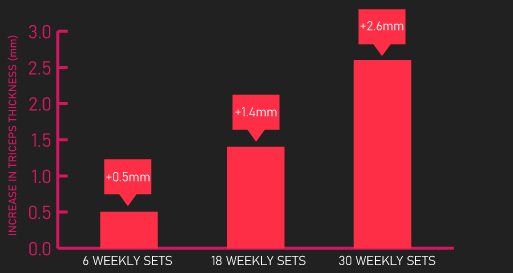
I should mention all of these sets were from compound exercises only, half of the sets for each group were from the bench press and the other half from the barbell overhead press. Also, each group distributed their sets across 3 days each week and training lasted 8 weeks.
Brigatto et al. similarly found that when trained subjects used 60 seconds of rest between sets, performing 32 weekly sets for the triceps was superior to 24 weekly sets or 16 weekly sets.

For each group, half of their sets were from compound exercises while the other half were from isolation exercises. Each group distributed their sets across 2 days each week and training lasted 8 weeks.
Lastly, Radaelli et al. found that when subjects with previous calisthenics experience used 90-120 seconds of rest between sets, performing 45 weekly sets for the triceps was superior to 27 weekly sets or 9 weekly sets.

For each group 2/3 of their sets were from compound exercises, while 1/3 were from isolation exercises. Each group distributed their sets across 3 days each week and training lasted 6 months.
So overall, when using shorter rest intervals, between 30-45 weekly sets for the triceps appears to be superior to fewer sets.
Now, 30-45 weekly sets with short rest intervals is a substantial amount of work. I question how sustainable this kind of work can be in the long term. The Schoenfeld and Brigatto studies only lasted 8 weeks, but the Radaelli study did last 6 months. I think it’d be useful to see more studies like the Radaelli study to determine if this kind of work is truly sustainable long term.
Nevertheless, the best advice I can give is that if you prefer to use shorter rest intervals, try out this kind of volume and figure out how well it may work for you. If you feel your recovery and performance begin to decline, adding in occasional training blocks where you utilize lower weekly sets for recovery may be a useful strategy.
Another important consideration is all of these studies were conducted on trained individuals. The Schoenfeld and Brigatto studies had subjects with at least 1 year of training experience, while the Radaelli study had subjects with previous calisthenics training experience, though they did not state the duration of their experience.
Trained individuals experience blunted anabolic responses to training, less muscle damage, and faster recovery of performance. This all indicates trained individuals would benefit from higher weekly sets versus untrained individuals.
Therefore, I think it’s highly likely untrained individuals would experience sufficient triceps growth using fewer than 30-45 weekly sets with shorter rest intervals. Perhaps 15-20 may be sufficient. Hopefully future research can confirm this.
Moving on to longer rest intervals, Ostrowski et al. found that when trained subjects rested for 3 minutes between sets, there was no difference between performing 14 weekly sets for the triceps or 28 weekly sets, but both were more effective than performing 7 weekly sets.

For each group, half of their sets came from compound exercises while the other half were from isolation exercises. Also, each group distributed their sets over 2 days each week and training lasted 10 weeks.
Therefore, it seems with longer rest intervals, 14 weekly sets for the triceps may be sufficient, performing more seems to provide no further benefit.
However, there is a potential limitation with this study. Subjects distributed their weekly sets across 2 days a week. The 28 weekly set group were performing 16 sets in one session and 12 sets in their second session each week.
This is quite a bit of volume in each training session. Theoretically, there may be a limit to the number of effective sets you can perform per session.
Two of the short rest interval studies we assessed a moment ago, finding more hypertrophy with more sets, had subjects distribute their volume across 3 days each week.
Therefore, with the Ostrowski study, the 28 weekly set group could have experienced more hypertrophy if subjects trained three or more days each week.
But this is speculative. As far as I’m aware, this is the only paper to have assessed the impacts of weekly sets on triceps hypertrophy with longer rest intervals.
Now, the research using short rest intervals indicates up to 30-45 weekly sets for the triceps is superior. When using longer rest intervals, it would make sense that fewer weekly sets should be sufficient for hypertrophy.
As mentioned, with the same number of sets, longer rest intervals produce more hypertrophy. So in essence, using longer rest intervals makes each set more effective.
As a result, generally, I think performing anywhere from 14 to 28 weekly sets may be fine if you’re using long rest intervals.
For people with numerous years of training experience, weekly sets on the higher end may be beneficial. Untrained individuals would probably experience a sufficient stimulus towards the lower end.
As some of you probably noticed, in all of the mentioned studies, we treated compound exercises and isolation exercises equally. That is, one set on the bench press was counted as one set for the triceps, and one set of an isolation tricep exercise was also counted as one set for the triceps.
However, some individuals consider one set of compound exercises, like the bench press, to only contribute to maybe 0.5 sets for the triceps. This assumes that compound exercises are slightly less stimulatory than isolation exercises for certain muscles.
But, as we detailed in the exercise selection portion of the article, if you combine a few triceps isolation exercises with your compound exercises, as is recommended, all of your exercises are not going to be identical stimuli for the triceps. In essence, each exercise, regardless of if it’s compound or isolation, serves a slightly different purpose for overall triceps hypertrophy.
Therefore, much of your weekly sets for the triceps are not identical stimuli.
Given this, I think it’s much simpler to just accept this but continue to count each set of an exercise that trains the triceps, regardless of whether it’s compound or isolation, as one set. As they did in the research we assessed.
High vs Low Frequency for Triceps Growth
Now, let us explore if you should be training your triceps with a low frequency or high frequency?
In this case, frequency refers to the number of days per week you train your triceps. In other words, it tells us how many days a week you distribute your weekly triceps sets across.
Interestingly, there is some evidence suggesting the triceps may take longer to recover than other muscle groups. Indeed, I have seen some individuals recommend that the triceps be trained less frequently due to this evidence.
However, the details are important.
The evidence I’m referring to is a study by Chen et al.
They had 9 untrained men perform a training session in which they trained a variety of muscle groups, including the triceps, with a variety of eccentric contractions.
For each exercise, they performed 5 sets of 10 eccentric reps. Meaning they only performed the lowering phase of each exercise, not the concentric lifting phase. Eccentric contractions are more damaging and require longer recovery durations than concentric contractions. So overall, this training session was pretty taxing.
The maximal force they could produce with each muscle group and the degree of muscle soreness was measured 2 days before the training session, immediately before the session, immediately after the session, and 1, 2, 3, 4, and 5 days after the session.

The triceps experienced greater decreases in force production and more soreness compared to quite a few other muscle groups.
Therefore, this study indicates that when you first begin training, the triceps may take longer to recover compared to many other muscle groups.
Despite this, it’s very important to understand the body does produce a range of adaptations following training sessions that result in you experiencing less muscle damage and faster recovery. In the research, this is called the repeated bout effect.
The Chen et al. study, 2 weeks after the initial training session, had the subjects perform the exact same training protocol again.

This time around, all muscle groups experienced less decrease in force production and muscle soreness in the following days after the session.
Now, the triceps still experienced greater force loss and soreness compared to some other muscle groups.
But, it’s very likely that if you train the triceps consistently for a few weeks, the body will produce a range of adaptations that significantly speed up the recovery process.
A study by Akgai et al. demonstrates this.
They assigned 23 untrained men into a training or control group. The control group did nothing.
The training group trained dumbbell triceps skull crushers for 5 sets of 8 reps with an 80% one-rep max load with 90 seconds of rest between sets, 3 times per week for 6 weeks.
Before and after the study, the shear modulus of the triceps was measured for both groups. Shear modulus measures the hardness of a muscle.
In essence, the harder the muscle, the more muscle damage probably present.
After the study, there was no difference between the training group and the control group in the shear modulus of the triceps. Moreover, there was no difference in shear modulus between the before and after measurements for both groups.
Therefore, it seems the training group was not experiencing any damage to the triceps by week 6.
The same research group had previously found that one day after performing triceps skull crushers there was an increase in the shear modulus of the triceps, suggesting muscle damage.
All this information nicely demonstrates the repeated bout effect.
Although initially, the triceps may take longer to recover compared to other muscle groups, over time, thanks to the adaptations produced by the body, this would not matter. The triceps will likely have the ability to recover significantly faster. This same information very likely applies to any other muscle group too.
I say all this to say that the triceps can likely ultimately be trained with higher frequencies without recovery being an issue.
Having that said, let us now actually evaluate the long-term research exploring the triceps response to lower and higher frequencies.
Brigatto et al. found that in men with an average of 4 and a half years of training experience performing 16 weekly sets for the triceps, there was no difference in triceps growth between training once per week or twice per week.

As a note, half of their weekly sets were from compound exercises, and the other half from isolation exercises. They rested 2 minutes between sets.
Somewhat similarly, Saric et al. found in men with at least 6 months of training experience performing 12 weekly sets for the triceps, there was no difference in triceps growth between training three times per week or 6 times per week.
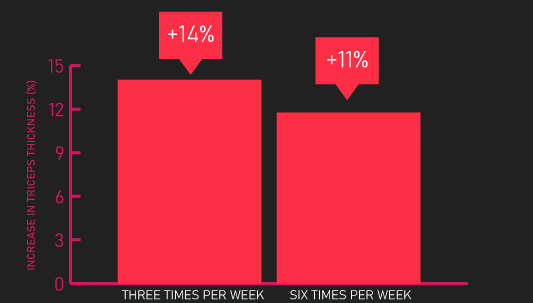
All 12 sets were from isolation exercises. They rested 60-90 seconds between sets. image
Collectively, these two studies suggest that the number of times you train the triceps per week is irrelevant for hypertrophy.
However, there are studies that oppose this.
Lasevicius et al. found in men with an average of 3 years of training experience performing 24 weekly sets for the triceps, triceps growth favored training twice per week versus three times per week.

Half of their weekly sets were from compound exercises and the other half from isolation exercises. They rested 90 seconds between sets.
Contrastingly, Schoenfeld et al. found that when men with an average of 4 and a half years of training experience performed 15 weekly sets for the triceps, training three times per week was superior to training twice per week.

9 weekly sets from compound exercises and the remaining 6 from isolation exercises. They used 60-90 second rest intervals between sets.
Another study by Zaroni et al. found that in men with an average of 6 and a half years of training experience performing 30 weekly sets for the triceps, distributing this volume over 5 days a week was superior to training twice per week.

Half of their weekly sets were from compound exercises and the other half from isolation exercises. They rested 60 seconds between sets.
Combining the overall evidence, it’s completely unclear what training frequency may be optimal for triceps growth.
Ultimately, more research is needed here. Also, all of these studies used short rest intervals. I’m not aware of any research using long rest intervals that evaluated the impacts of different training frequencies on triceps growth.
Now, part of conflicting evidence may just be down to individual differences.
Training variables like training frequency as well as volume may be quite individualized. That is to say, different individuals may respond best to different training frequencies and volumes.
A paper by Damas et al. nicely demonstrates this.
They had 19 untrained men train one of their legs with a high frequency and volume protocol and their other leg with a low frequency and volume protocol.
The high frequency and volume leg trained the unilateral leg extension for 3 sets of 9-12 to failure 5 times per week.
The low frequency and volume leg also trained the unilateral leg extension for 3 sets of 9-12 to failure each session, but they trained two or three times per week.
As each subject trained both protocols, one leg performed one protocol and their other leg the other protocol, we can determine whether an individual is more responsive to a particular protocol.
For increases in vastus lateralis cross-sectional area increases, 6 subjects experienced the greatest increases with the high frequency and volume protocol, 7 subjects experienced the greatest increases with the low frequency and volume protocol, while the remaining 6 subjects responded similarly to both protocols.
As we can see, different individuals may respond better to different frequencies and volumes. Therefore, in the long term, you may wish to experiment with various training frequencies or volumes and figure out if there is any discernable difference between them.
Can Hypoxia Methods Enhance Triceps Hypertrophy?
The last section of this article that I thought would be an interesting addition is whether aiming to induce hypoxia with your triceps exercises could enhance triceps hypertrophy.
In our scenario, hypoxia refers to using some method of depriving the muscle of oxygen. If this makes little sense to you, don’t worry, it will make more sense to you as we look at the research.
A study by Goto et al. was the paper that inspired me to add this section.
44 men with at least 1 year of training experience were assigned to a partial range of motion or full range of motion group.
Both groups trained the triceps skull crusher for 3 sets of 8 reps, three times per week for 8 weeks.
The full range of motion group began with their elbows in full extension, lowering the weight to their maximal elbow flexion angle and then extending back to full extension.
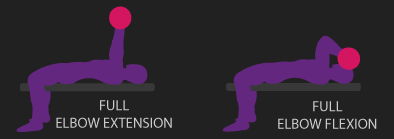
The partial range of motion group began with their elbows flexed to 45 degrees, lowering the weight to 90 degrees of elbow flexion, and then extending back to 45 degrees of elbow flexion.
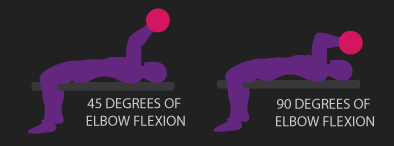
This technique would have induced significantly more hypoxia than the full range of motion group, as the constant contractions would likely compress capillaries resulting in restricted blood flow to the triceps.
Increases in triceps cross-sectional area, measured at 60% of the upper arm length, was significantly greater for the partial range of motion group.
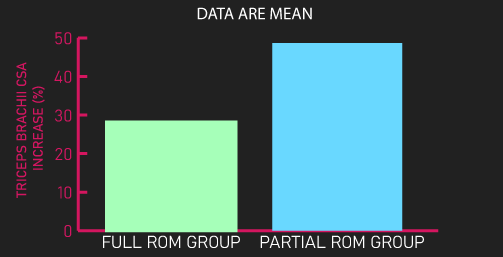
For the partial range of motion group, the researchers also measured the degree of hypoxia experienced by the subjects after performing the partial range of motion skull crushers.
Something extremely interesting was that the researchers found a correlation between the degree of hypoxia experienced by subjects and their increase in triceps cross-sectional area.

Put differently, the subjects in the partial range of motion group that experienced the highest degree of hypoxia also experienced the greatest increases in triceps cross-sectional area.
Another study by Fink et al. also somewhat agrees with this study.
16 untrained men were split into a drop set or normal set group.
Both groups trained the triceps pushdown, twice per week for 8 weeks.
The normal set group performed three sets to failure with a 12 rep-max load and 90 seconds of rest between sets.
The drop set group performed a single set to failure with a 12 rep-max load, immediately decreasing the load by 20% each time failure was reached 3 times in a row.
Due to the numerous continuous contractions, it’s likely the drop set group would have been experiencing greater hypoxia than the normal set group.
Increases in triceps cross-sectional area, measured at 60% of the upper arm length, favor the drop set group.
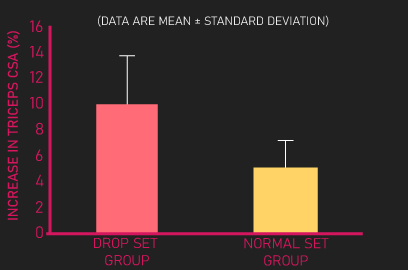
At the time of recording, I believe this is the only study finding drop set training produces greater hypertrophy than normal sets. All of the other studies, which were conducted on either the biceps or quadriceps, found no difference between the two.
This raises an interesting question: could there be something special about the triceps that makes them more responsive to hypoxia?
Unfortunately, I’m unaware of any evidence that can support this claim.
Additionally, there are other lines of evidence that indicate hypoxia does not augment triceps growth.
Tanimoto et al. had subjects train 8 weeks with either the normal chest press or the chest press without locking out their elbows, which likely would have produced greater triceps hypoxia than normal chest press reps.
However, both exercises produced similar increases in triceps thickness.
Furthermore, two papers indicate adding blood flow restriction bands to the upper arms during the bench press, which would likely produce greater hypoxia than non-blood flow restriction training, produced similar increases in triceps cross-sectional area compared to normal bench press training without blood flow restriction.
So overall, it’s not clear if partial range of motion skull crushers or drop set training formats truly produce greater triceps hypertrophy. More research is needed.
Although, I don’t see any real downside to including some drop set training or partial range of motion constant tension training for the triceps. So I think it may be perfectly fine to do so.
Summary
We’ve gone through a lot of information and research on how one could go about maximizing triceps hypertrophy, let us summarize the key points.
1) Performing 2-3 triceps isolation exercises on top of your compound exercises should not only ensure each triceps head is trained sufficiently but different regions within each triceps head are also sufficiently targeted.
2) As for rep ranges, the research suggests that provided you perform your repetitions to or very close to failure, reps between 5 and 35 should produce similar triceps hypertrophy.
3) With regards to volume, if you use shorter rests between sets (around 2 minutes less), 30-45 weekly sets seem to produce greater triceps growth than fewer sets. But I question how sustainable this kind of work can be long term, maybe adding in training blocks with lower weekly sets may be necessary here.
Now, this recommendation is derived from research on trained individuals, untrained individuals can likely achieve sufficient adaptations with fewer weekly sets.
If you use longer rest rests between sets (3 minutes or more), there isn’t a good deal of research. As a broad recommendation, anywhere from 14 to 28 weekly sets may work well. Untrained individuals may experience optimal adaptations on the lower end, whereas more trained individuals may benefit from the higher end.
4) Regarding training frequency, the research is completely conflicting. Some studies indicate no difference between various frequencies, others suggest a benefit to higher frequencies and even one indicates a benefit to lower frequencies.
In part, individual differences could explain the conflicting evidence. Some individuals may respond best to certain frequencies. So you may wish to individually experiment or simply chose a frequency that fits your schedule.
Bear in mind, individual differences apply to the discussion on volume. So you may wish to individually experiment with lower or higher volumes or simply go with whatever fits your schedule.
5) Finally, you could perform one of your isolation triceps exercises with a constant tension technique, or with drop sets, as some evidence indicates this enhances triceps hypertrophy. Though there is research somewhat opposing this, so it’s perfectly fine to not do this.
Remember to feel free to check out the Alpha Progression App if you’re interested. Also feel free to check out our free bench press e-book below.


Great stuff, love your website and videos!
Thank YOU so much Eric, awesome to hear!